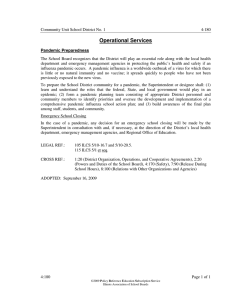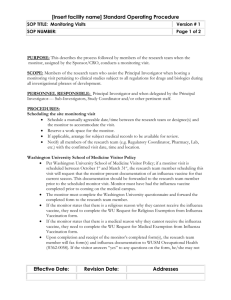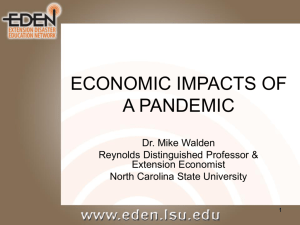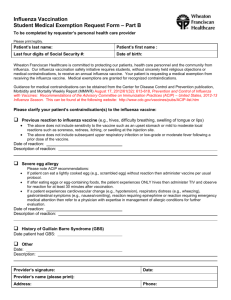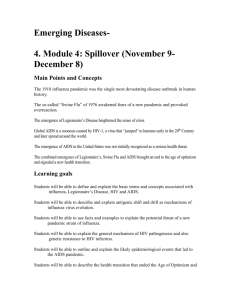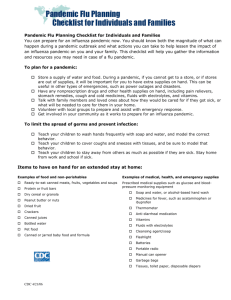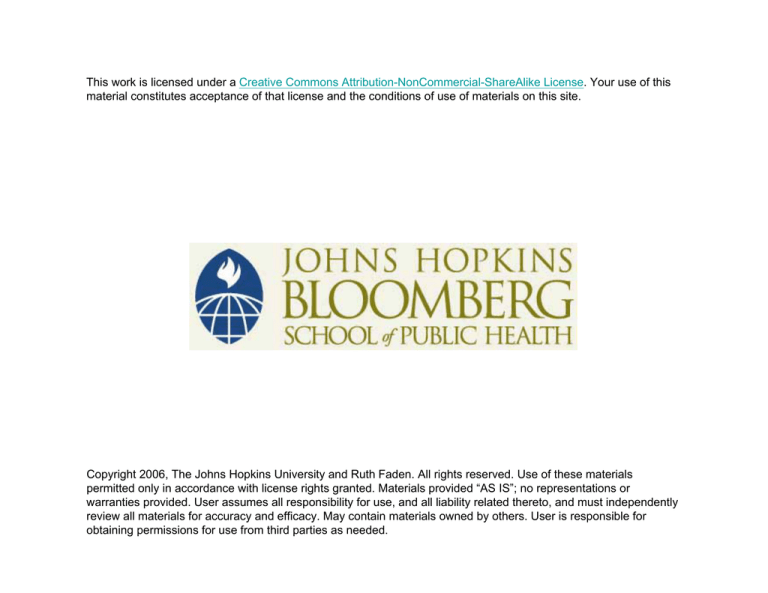
This work is licensed under a Creative Commons Attribution-NonCommercial-ShareAlike License. Your use of this
material constitutes acceptance of that license and the conditions of use of materials on this site.
Copyright 2006, The Johns Hopkins University and Ruth Faden. All rights reserved. Use of these materials
permitted only in accordance with license rights granted. Materials provided “AS IS”; no representations or
warranties provided. User assumes all responsibility for use, and all liability related thereto, and must independently
review all materials for accuracy and efficacy. May contain materials owned by others. User is responsible for
obtaining permissions for use from third parties as needed.
Ethical Issues in Public Health ---- Group Assignment Case Study
PANDEMIC FLU IN THE U.S.: ETHICS & THE ALLOCATION OF A SCARCE
VACCINE
DIRECTIONS
Part 1: Critique of HHS Policy Recommendations
Students will form small groups of 3-4 people to conduct a public health ethics task force
simulation for the influenza vaccine allocation case study described in the following pages. Each
group will take on the role of a National Advisory Commission to the President charged with
providing advice on the ethical acceptability of a proposed prioritization scheme (pages 3-8) to
distribute scarce influenza vaccine in the event of an outbreak of pandemic flu in the U.S.
Each group will turn in a 5 page double spaced policy critique based on its analysis of the case.
Your recommendations will be reviewed by your TA, and by members of a group from the
alternate discussion section (Part 2 below).
Guidance for the process of your ethical analysis can be found in the assigned readings for
sessions #1 through 3.
Examples of the ethical considerations sometimes employed in the allocation of scarce resources
that you may wish to discuss in your deliberations are provided in the supplemental information
provided with this case (see page 9).
Except for the assigned and recommended readings for the course, you may not consult any
published ethical analyses on or related to the topic of the case study.
Your grade for this assignment will be based upon the following criteria:
Length
Spelling & Grammar
Clarity
Organization
Moral Analysis
10 points
10 points
15 points
15 points
50 points
Part 2: Critique of Student Policy Recommendations
In addition to the group assignment described above, you will individually provide a 1-2
paragraph critique of the recommendations developed by a group from the alternate discussion
section.
2
Background
The unprecedented outbreak of the H5N1 strain of the Influenza A virus in birds across Asia and
Europe has lead to increasing concerns over the threat of an outbreak of pandemic flu in the near
future. Pandemic flu can occur when a novel influenza virus emerges and can be efficiently
transmitted between humans. As of this writing, the H5N1 virus is known to have infected 121
people in four countries, resulting in 62 deaths over two years. While it is not possible to predict
if or when this particular virus will cause a pandemic, history suggests that one or more
pandemics will occur in this century. The last three pandemics (1918, 1957, & 1968)
respectively killed approximately 40 million, 2 million, and 1 million persons worldwide.
In the event of a pandemic outbreak, vaccinations against the virus will be critical components of
any attempt to mitigate the potentially devastating health and societal effects of the disease. In
the U.S., it is estimated that it will be between 3 and 6 months after an outbreak of pandemic flu
before the first doses of a vaccine against the particular strain of the virus will be available. It is
also assumed that two doses per person will be needed in order to provide protection. Once a
vaccine is available, it is assumed that the U.S. will have the capacity to produce 3 to 5 million
doses (enough for about 1% of the U.S. population) per week.
Because vaccines will be in short supply during a pandemic, the Department of Health and
Human Services (HHS) in its Pandemic Influenza Plan has provided guidelines based on
advisory committee recommendations concerning the prioritization of vaccine distribution. The
stated goals of the priority scheme, and the schemes themselves, are listed on the following
pages (3-8).
Imagine that you are a member of a National Advisory Commission appointed by the President
to advise him and the public. Your specific charge is to determine whether the guidelines for
prioritizing vaccine distribution proposed by HHS are ethically acceptable. You have been asked
to:
1) Identify moral reasons why groups given low priority may perceive the scheme as unfair.
2) Critique the rationales provided by HHS for their recommended priorities to see if
important moral arguments in favor of their recommendations are overlooked.
3) Recommend changes in the proposed rank ordering if in your commission’s judgment
any are needed from the standpoint of ethical considerations.
3
Table 1: Vaccine Priority Group Recommendations1
Tier Subtier Population
A
Vaccine and antiviral manufacturers and others
1
essential to manufacturing and critical support
(~40,000)
B
Rationale
Need to assure maximum production of
vaccine and antiviral drugs
Medical workers and public health workers who
are involved in direct patient contact, other
support services essential for direct patient care,
and vaccinators (8-9 million)
Healthcare workers are required for quality medical
care (studies show outcome is associated with staff-topatient ratios). There is little surge capacity among
healthcare sector personnel to meet increased demand.
Persons > 65 years with 1 or more influenza
high-risk conditions, not including essential
hypertension (approximately 18.2 million)
These groups are at high risk of hospitalization and
death. Excludes elderly in nursing homes and those
who are immunocompromised and would not likely be
protected by vaccination
Persons 6 months to 64 years with 2 or more
influenza high-risk conditions, not including
essential hypertension (approximately 6.9
million)
Persons 6 months or older with history of
hospitalization for pneumonia or influenza or
other influenza high-risk condition in the past
year (740,000)
C
Pregnant women (approximately 3.0 million)
Household contacts of severely
immunocompromised persons who would not
be vaccinated due to likely poor response to
vaccine (1.95 million with transplants, AIDS,
and incident cancer x 1.4 household contacts
per person = 2.7 million persons)
Household contacts of children <6 month olds
(5.0 million)
D
Public health emergency response workers
critical to pandemic response (assumed
one-third of estimated public health
workforce=150,000)
Key government leaders
1
In past pandemics and for annual influenza,
pregnant women have been at high risk;
vaccination will also protect the infant who cannot
receive vaccine.
Vaccination of household contacts of
immunocompromised and young infants
will decrease risk of exposure and infection
among those who cannot be directly protected by
vaccination.
Critical to implement pandemic response
such as providing vaccinations and
managing/monitoring response activities
Preserving decision-making capacity also critical
for managing and implementing a response
The committee focused its deliberations on the U.S. civilian population. ACIP and NVAC recognize that Department of
Defense needs should be highly prioritized. DoD Health Affairs indicates that 1.5 million service members would require
immunization to continue current combat operations and preserve critical components of the military medical system. Should the
military be called upon to support civil authorities domestically, immunization of a greater proportion of the total force will
become necessary. These factors should be considered in the designation of a proportion of the initial vaccine supply for the
military. Other groups also were not explicitly considered in these deliberations on prioritization. These include American
citizens living overseas, non-citizens in the U.S., and other groups providing national security services such as the border patrol
and customs service.
4
Table 1 (Continued)
Tier Subtier Population
A
Healthy 65 years and older (17.7 million)
2
Rationale
Groups that are also at increased risk but not as high
risk as population in Tier 1B
6 months to 64 years with 1 high-risk condition
(35.8 million)
6-23 months old, healthy (5.6 million)
B
Other public health emergency responders
(300,000 = remaining two-thirds of public
health work force)
Public safety workers including police, fire,
911 dispatchers, and correctional facility staff
(2.99 million)
Includes critical infrastructure groups that have
impact on maintaining health (e.g., public safety
or transportation of medical supplies and food);
implementing a pandemic response; and on
maintaining societal functions
Utility workers essential for maintenance of
power, water, and sewage system functioning
(364,000)
Transportation workers transporting fuel, water,
food, and medical supplies as well as public
ground public transportation (3.8 million)
Telecommunications/IT for essential network
operations and maintenance (1.08 million)
3
Other key government health decision-makers
(estimated number not yet determined)
Other important societal groups for a pandemic
response but of lower priority
Funeral directors/embalmers (62,000)
4
Healthy persons 2-64 years not included in
above categories (179.3 million)
All persons not included in other groups based
on objective to vaccinate all those who want
protection
5
NVAC/ACIP recommendations for prioritization of pandemic
influenza vaccine and NVAC recommendations on pandemic
antiviral drug use2
Advisory Committee recommendations are presented in this report to provide guidance for planning purposes and to
form the basis for further discussion of how to equitably allocate medical countermeasures that will be in short
supply early in an influenza pandemic. Two federal advisory committees, the Advisory Committee on
Immunization Practices (ACIP) and the National Vaccine Advisory Committee (NVAC), provided
recommendations to the Department of Health and Human Services on the use of vaccines and antiviral drugs in an
influenza pandemic. Although the advisory committees considered potential priority groups broadly, the main
expertise of the members was in health and public health. The primary goal of a pandemic response considered
was to decrease health impacts including severe morbidity and death; secondary pandemic response goals
included minimizing societal and economic impacts. However, as other sectors are increasingly engaged in
pandemic planning, additional considerations may arise. The advisory committee reports explicitly acknowledge the
importance of this, for example highlighting the priority for protecting critical components of the military. Finally,
HHS has recently initiated outreach to engage the public and obtain a broader perspective into decisions on priority
groups for pandemic vaccine and antiviral drugs. Though findings of the outreach are preliminary, a theme that has
emerged is the importance of limiting the effects of a pandemic on society by preserving essential societal functions.
On July 19, 2005, ACIP and NVAC voted unanimously in favor of the vaccine priority recommendations
summarized in Table 1. These votes followed deliberations of a joint Working Group of the two committees, which
included as consultants representatives of public and private sector stakeholder organizations and academic experts.
There was limited staff level participation from DoD, DHS, and VA. Several ethicists also served as consultants to
the Working Group.
A. Critical assumptions
The recommendations summarized in Table 1 were based on the following critical assumptions:
■ Morbidity and mortality - - The greatest risk of hospitalization and death—as during the 1957 and 1968
pandemics and annual influenza—will be in infants, the elderly, and those with underlying health conditions. In the
1918 pandemic, most deaths occurred in young adults, highlighting the need to reconsider the recommendations at
the time of the pandemic based on the epidemiology of disease.
■ Healthcare system - - The healthcare system will be severely taxed if not overwhelmed due to the large number
of illnesses and complications from influenza requiring hospitalization and critical care. CDC models estimate
increases in hospitalization and intensive care unit demand of more than 25% even in a moderate pandemic.
■ Workforce - - During a pandemic wave in a community, between 25% and 30% of persons will become ill during
a 6 to 8 week outbreak. Among working-aged adults, illness attack rates will be lower than in the community as a
whole. A CDC model suggests that at the peak of pandemic disease, about 10% of the workforce will be absent due
to illness or caring for an ill family member. Impacts will likely vary between communities and work sites and may
be greater if significant absenteeism occurs because persons stay home due to fear of becoming infected.
■ Critical infrastructure - - Only limited information was available from which to assess potential impacts on
critical infrastructure sectors such as transportation and utility services. Because of changes in business practices and
the complexity of networks, information from prior pandemics was not considered applicable.
■ Vaccine production capacity - - The U.S.-based vaccine production capacity was assumed at 3 to 5 million 15µg
doses per week with 3 to 6 months needed before the first doses are produced. Two doses per person were assumed
to be required for protection. Subsequent results of an NIH clinical trial of influenza A (H5N1) vaccine suggest that
2
Taken from Appendix D of the HHS Pandemic Influenza Plan, 2005. Available
http://www.hhs.gov/pandemicflu/plan/
6
higher doses of antigen will be needed to elicit a good immune response; thus, the assumptions made by the
committee could potentially substantially exceed the amount of vaccine that would be produced.
Definitions and rationales for priority groups
1. Healthcare workers and essential healthcare support staff
a) Definition
Healthcare workers (HCW) with direct patient contact (including acute-care hospitals, nursing homes, skilled
nursing facilities, urgent care centers, physician’s offices, clinics, home care, blood collection centers, and EMS)
and a proportion of persons working in essential healthcare support services needed to maintain healthcare services
(e.g. dietary, housekeeping, admissions, blood collection center staff, etc.). Also included are healthcare workers in
public health with direct patient contact, including those who may administer vaccine or distribute influenza
antiviral medications, and essential public health support staff for these workers.
b) Rationale
The pandemic is expected to have substantial impact on the healthcare system with large increases in demand for
healthcare services placed on top of existing demand. HCW will be treating influenza-infected patients and will be
at risk of repeated exposures. Further, surge capacity in this sector is low. To encourage continued work in a highexposure setting and to help lessen the risk of healthcare workers transmitting influenza to other patients and HCW
family members, this group was highly prioritized. In addition, increases in bed/nurse ratios have been associated
with increases in overall patient mortality. Thus, substantial absenteeism may affect overall patient care and
outcomes.
2. Groups at high risk of influenza complications
a) Definition
Persons 2-64 years with a medical condition for which influenza vaccine is recommended and all persons 6-23
months and 65 years and older. Excludes nursing home residents and severely immunocompromised persons who
would not be expected to respond well to vaccination.
b) Rationale
These groups were prioritized based on their risk of influenza-related hospitalization and death and also their
likelihood of vaccine response. Information from prior pandemics was used whenever possible, but information
from interpandemic years was also considered. Nursing home residents and severely immunocompromised persons
would be prioritized for antiviral treatment and/or prophylaxis and vaccination of healthcare workers and household
contacts who are most likely to transmit influenza to these high risk groups.
3. Critical infrastructure
a) Definitions and rationale
Those critical infrastructure sectors that fulfill one or more of the following criteria: have increased demand placed
on them during a pandemic, directly support reduction in deaths and hospitalization; function is critical to support
the healthcare sector and other emergency services, and/or supply basic necessities and services critical to support of
life and healthcare or emergency services. Groups included in critical infrastructure are needed to respond to a
pandemic and to minimize morbidity and mortality, and include the following sectors:
■ Persons directly involved with influenza vaccine and antiviral medication manufacturing and distribution and
essential support services and suppliers (e.g., growers of pathogen-free eggs for growth of vaccine virus) production
activities
■ Key government leaders and health decision-makers who will be needed to quickly move policy forward on
pandemic prevention and control efforts
7
■ Public safety workers (firefighters, police, and correctional facility staff, including dispatchers) are critical to
maintaining social functioning and order and will contribute to a pandemic response, for example by ensuring order
at vaccination clinics and responding to medical emergencies
■ Utility service workers (water, power, and sewage management) are prioritized as the services they provide are
also essential to the healthcare system as well as to preventing additional illnesses from lack of these services
unrelated to a pandemic.
■ Transportation workers who maintain critical supplies of food, water, fuel, and medical equipment and who
provide public transportation, which is essential for provision of medical care and transportation of healthcare
workers to work and transportation of ill persons for care
■ Telecommunication and information technology services critical for maintenance and repairs of these systems are
also essential as these systems are now critical for accessing and delivering medical care and in support of all other
critical infrastructure.
■ Mortuary services will be substantially impacted due to the increased numbers of deaths from a pandemic and the
fact that impact will be high in the elderly, a growing segment of the population
4. Public health emergency response workers
a) Definition
This group includes persons who do not have direct patient care duties, but who are essential for surveillance for
influenza, assessment of the pandemic impact, allocation of public health resources for the pandemic response,
development and implementation of public health policy as part of the response, and development of guidance as the
pandemic progresses.
b) Rationale
Persons in this sector have been critical for past influenza vaccine pandemics and influenza vaccine shortages and
little surge capacity may be available during a public health emergency such as a pandemic.
5. Persons in skilled nursing facilities
a) Definition
Patients residing in skilled nursing facilities. Not included in this group are persons in other residential settings (e.g.,
assisted living) who are more likely to be mobile, in a setting that is less closed, and have decentralized healthcare.
b) Rationale
This group was not prioritized for vaccine because of the medical literature finding poor response to vaccination and
occurrence of outbreaks even in the setting of high vaccination rates. Other studies have suggested that vaccination
of healthcare workers may be a more effective strategy to prevent influenza in this group. Further, surveillance for
influenza can be conducted in this group and antiviral medications used widely for prophylaxis and treatment. Ill
visitors and staff should also be restricted from visiting nursing home facilities during outbreaks of pandemic
influenza. This strategy for pandemic influenza vaccine differs from the interpandemic vaccination strategy of
aggressively vaccinating nursing home residents. The rationale considers several factors: 1) these populations are
less likely to benefit from vaccine than other groups who are also at high risk; 2) other prevention strategies feasible
for this group are not possible among other high-risk groups; 3) the overall morbidity and mortality from pandemic
is likely to severely impact other groups of persons who would be expected to have a better response to the vaccine;
and 4) a more severe shortage of vaccine is anticipated.
6. Severely immunocompromised persons
a) Definition
Persons who are undergoing or who have recently undergone bone marrow transplantation and others with severe
immunodeficiency (e.g., AIDS patients with CD4 counts <50, children with SCID syndrome, recent bone marrow
8
transplant patients). The numbers of persons in these categories is likely much smaller than the anticipated number
assumed in tiering above, but sources for more specific estimates have not been identified.
b) Rationale
These groups have a lower likelihood of responding to influenza vaccination. Thus, strategies to prevent severe
influenza illness in this group should include vaccination of healthcare workers and household contacts of severely
immunocompromised persons and use of antiviral medications. Consideration should be given to prophylaxis of
severely immunocompromised persons with influenza antivirals and early antiviral treatment should they become
infected.
7. Children <6 months of age
a) Rationale
Influenza vaccine is poorly immunogenic in children <6 months and the vaccine is currently not recommended for
this group. In addition, influenza antiviral medications are not FDA-approved for use in children <1 year old. Thus,
vaccination of household contacts and out-of-home caregivers of children <6 months is recommended to protect this
high-risk group.
C. Other discussion
There was substantial discussion on priority for children. Four potential reasons were raised for making vaccination
of children a priority:
■ At the public engagement session, many participants felt that children should have high priority for vaccination.
■ Children play a major role in transmitting infection, and vaccinating this group could slow the spread of disease
and indirectly protect others.
■ Children have strong immune systems and will respond well to vaccine whereas vaccination of the elderly
and those with illnesses may be less effective.
■ Some ethical frameworks would support a pediatric priority. ACIP and NVAC did not make children a priority
(other than those included in tiers, because of their underlying diseases [Tiers 1B and 2A] or as contacts of high-risk
persons [Tier 1C]) for several reasons:
■ Healthy children have been at low risk for hospitalization and death in prior pandemics and during annual
influenza seasons.
■ It is uncertain whether vaccination of children will decrease transmission and indirectly protect others.
Studies that show this impact or mathematical models that predict it rely on high vaccination coverage
that may not be possible to achieve given limited supplies in a pandemic.
■ The committees recognize that this is an area for further scientific work; that children may be a good
target population for live-attenuated influenza vaccine (FluMist®) if it is available; and that education
of the public will be needed to provide the rationale for the recommendations. HHS Pandemic Influenza Plan
9
Ethical Considerations in Scarce Resource Allocation∗
Medical Success (Effectiveness) - - priority given to those most likely to achieve a good
outcome
Medical Need - - priority given to those most in need of medical intervention
Public Health Utility - - achieving the least morbidity/mortality possible given the resources
available (maximizing good health/survival with the available resources)
Immediate Usefulness - - priority given to those with special skills that could be used to serve
the common good in the immediate circumstance
General Social Value - - priority given to those who are considered by society to have the
greatest social worth (past or future)
Principle of Conservation - - priority given to those who use proportionally less resources
Responsibility for Dependents - - priority given to those who have primary responsibilities to
dependents (parents, nursing home attendants, etc.)
Generally Neediest - - priority given to those considered most helpless or generally neediest in
society
None if not all - - no one should saved if not all can be saved
Queue - - priority given on a first-come, first-served basis
Random Selection - - allocation determined by chance (a lottery, for example)
Ability to Pay - - priority given to those who can pay for the resources
Merit based - - priority given to those who have earned it due to past actions
NOTE: The above considerations are not necessarily mutually exclusive. You may develop a
position based on one principle, or you could develop a position which attempts to balance many
principles.
For example, you may develop of position which favors use of the “Medical Need/Effectiveness”
principle until a certain point in the pandemic, at which time the “Ability to Pay” principle may
become primary for you.
∗
Adapted from Gerald Winslow’s work, Triage and Justice (1982)

